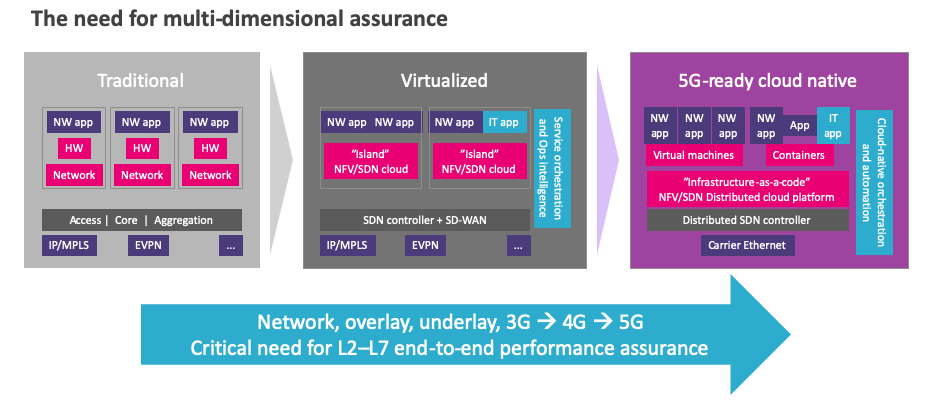And not only services monetization, but customer satisfaction and churn as well.
The evolution from 4G to 5G represents an exciting time in the networking world. 5G promises a host of new applications and services, along with the speed and performance guarantees to ensure an unprecedented user experience. The shift also represents a number of operational and technology challenges which could ultimately impact customer satisfaction.

Performance data has a major role to play as mobile operators navigate the move to 5G and cloud services – it is intrinsically tied to monetization and customer satisfaction in the shift to 5G.
There are three key challenges mobile operators are facing as they move to 5G. Let’s explore these in more detail.
And you can WATCH them in this webinar replay here.
1. The evolution from 5G non-standalone (NSA) to 5G standalone (SA)
The evolution from monolithic systems to a distributed architecture involves major changes in terms of shifting from 5G non-standalone (NSA) to 5G standalone (SA); static radio access networks (RAN) to Open RAN (O-RAN). This evolution enables interoperability, removes vendor lock and promotes standardization but also presents significant challenges.
2. Understanding the performance and security of multi-dimensional networks
The shift from 4G to 5G is significant, requiring operators to be able to interact with entirely new ecosystems. Multi-dimensional networks must be assured to provide the levels of speed, performance, and trust necessary to successfully monetize 5G and the edge. With 5G comes more data that is distributed across multiple locations (think MEC). This new paradigm creates more exposure making security an extremely important part of this shift.

3. Controlling customer satisfaction with optimal network performance
The days of break/fix are gone. Nuance changes and degradations must be understood and controlled to provide optimal network performance. This may be achieved using precision and correlation in real-time. Not only will this ensure service level agreements (SLAs) are met, but it will make sure everything can be orchestrated and operate properly together.
Practical applications of 5G and edge applications

An augmented reality (AR) street scene is an example of a valuable and easily monetized 5G application. Users could potentially see an “enhanced” version of reality including people’s names, ages, and job titles. Language could be translated on the fly. Products in store windows could display ads and additional information with the option to be virtually “tried on” by the user.
AR technology used with 5G also could assist in life and death situations. Think about a first responder who is going into a burning building and needs to know: Where is the victim? Which door can I open? Which one may have a hot spot behind it that would actually keep me from leaving this building?
In this case, enhanced AR could be used to pinpoint a victim’s location, health status, identity, etc. using ultra-reliable and ultra-low latency real-time communications (URLLC). It could also show egress points, the locations of other responder crew members, and indicate the best way of reaching and taking out a victim.
The FirstNet system, built with AT&T, is already working to help first responders in these ways. Established by the U.S. Congress in 2012, FirstNet is a high-speed, nationwide broadband wireless network dedicated exclusively to public safety. It is designed to handle extremely high volumes of data, including video, photos, and texts. 5G will further enhance these capabilities.
The system uses predictive analytics and artificial intelligence to correlate telemetry data, monitor situations and make intelligent predictions.
Why performance data matters
As 4G evolves to 5G, changes to the backhaul transport network are necessary. Capacity improvements are vital to supporting a new wave of 5G services, and multi-vendor, multi-cloud environments create complexities. Multi-Access Edge Compute (MEC) is set to become prevalent, and cloud infrastructure must be built to connect and orchestrate all of the necessary components.
It really is about full observability – being able to look at things at a very granular perspective but also from a contextual perspective. It’s not just about the kind of data, it’s about understanding what is that data, what does that data mean, what qualitative attributes does it bring?
The advent of 5G means that performance standards that have been traditionally acceptable for mobile environments is simply inadequate. High-quality performance data is necessary to help operators avoid degradations while also improving the user experience with the stricter requirements that 5G brings.
Customer satisfaction will become an even more important differentiator in the 5G world, and operators need to be mindful of the following variables to deliver consistent, trusted performance:
- Visibility. Traditional 5pps/200ms views do not reveal micro-impairments or microbursts. Deeper network visibility is required to maintain consistent performance.
- Granularity. Fifteen or even five-minute sampling is not good enough for LTE or 5G. Evolved networks require millisecond-sampling to maintain performance.
- Virtualization. As networks cloudify and move to open architectures, monitoring and virtualization must adapt to the new environments.
- Scalability. Networks and endpoints will continue to grow exponentially. Rapid deployments and mass scaling with a minimal footprint and TCO are necessary
- Coexistence. Operators must be able to work well with others, within multi-vendor scenarios. They must do this by leveraging their existing infrastructure while also strategically up-featuring as needed.
A common trust model that monitors and manages edge, IoT mesh, mesh underlay transport, edge-to-cloud, cloud-to-cloud, and operator-to-cloud performance, along with providing security threat detection, is vital to the evolution of 5G and edge services. Performance data is paramount to providing that common trust and is set to play a major role in the era of cloud and 5G services.
To learn more about how 5G performance monitoring offers a competitive advantage at the network edge, download our whitepaper on the topic.

 Improved delivery, better visibility: How Accedian and VMware are working together to help CSPs navigate the 5G world
Improved delivery, better visibility: How Accedian and VMware are working together to help CSPs navigate the 5G world
 Adding a new dimension of visibility to the Cisco Full-Stack Observability portfolio with Accedian Skylight
Adding a new dimension of visibility to the Cisco Full-Stack Observability portfolio with Accedian Skylight